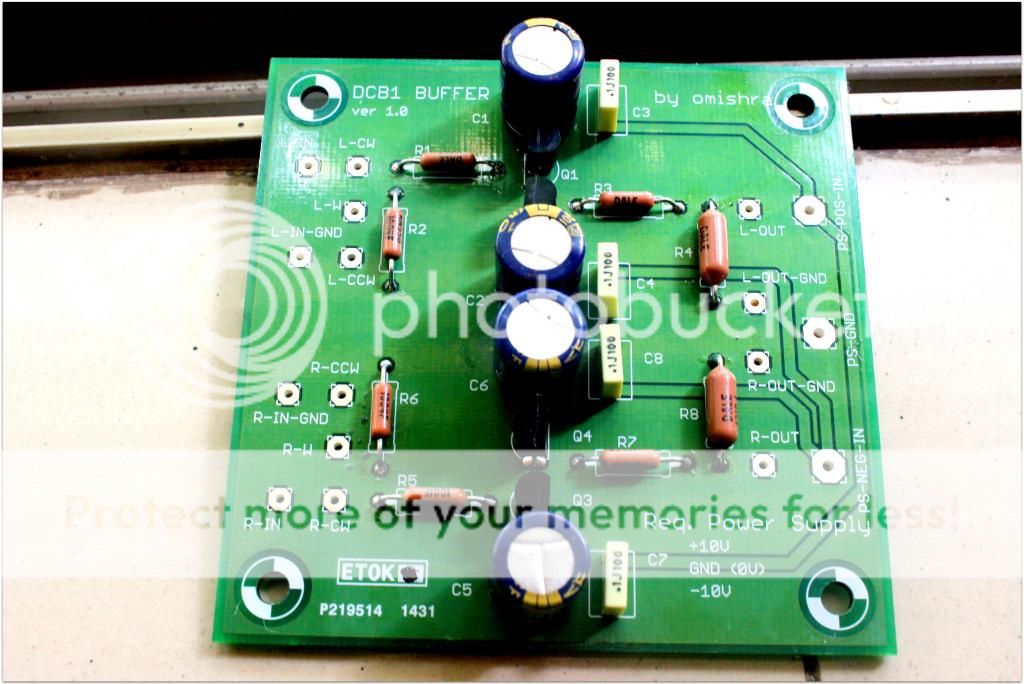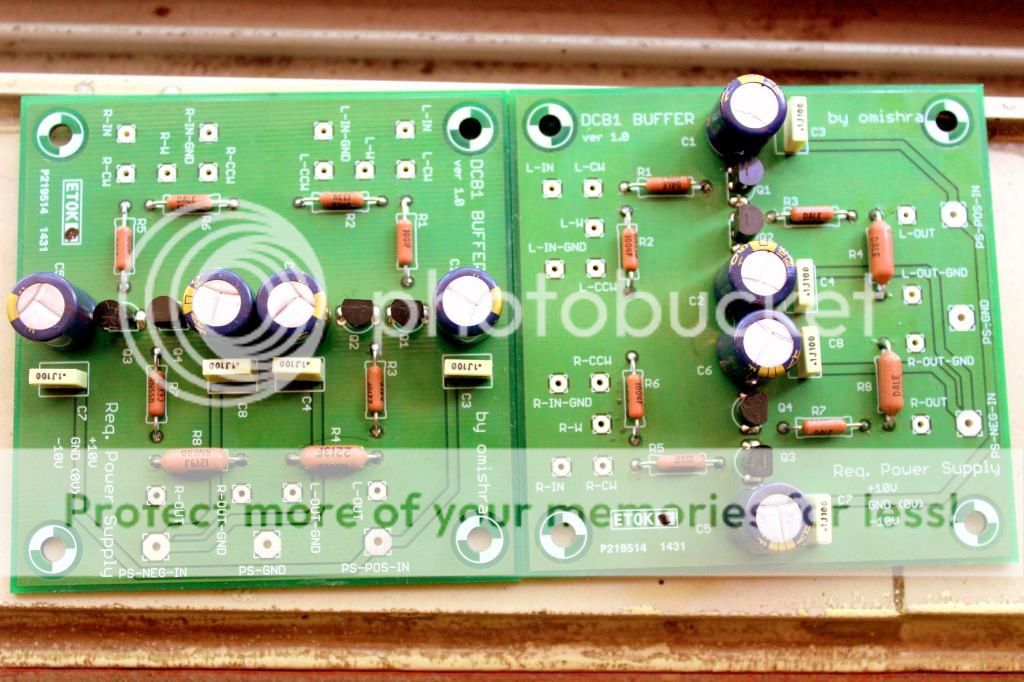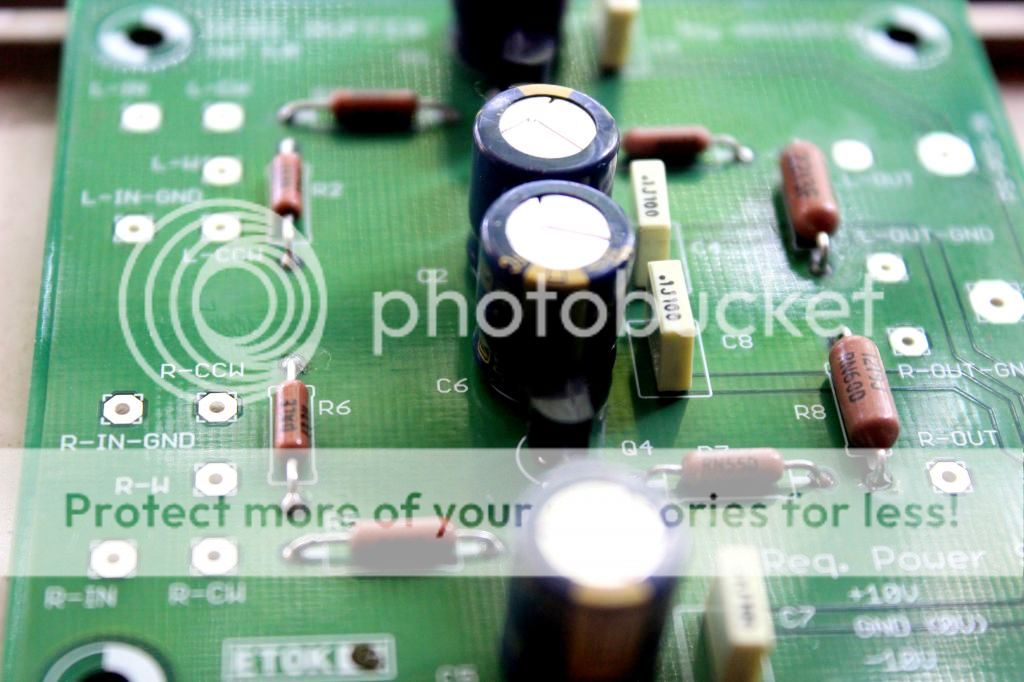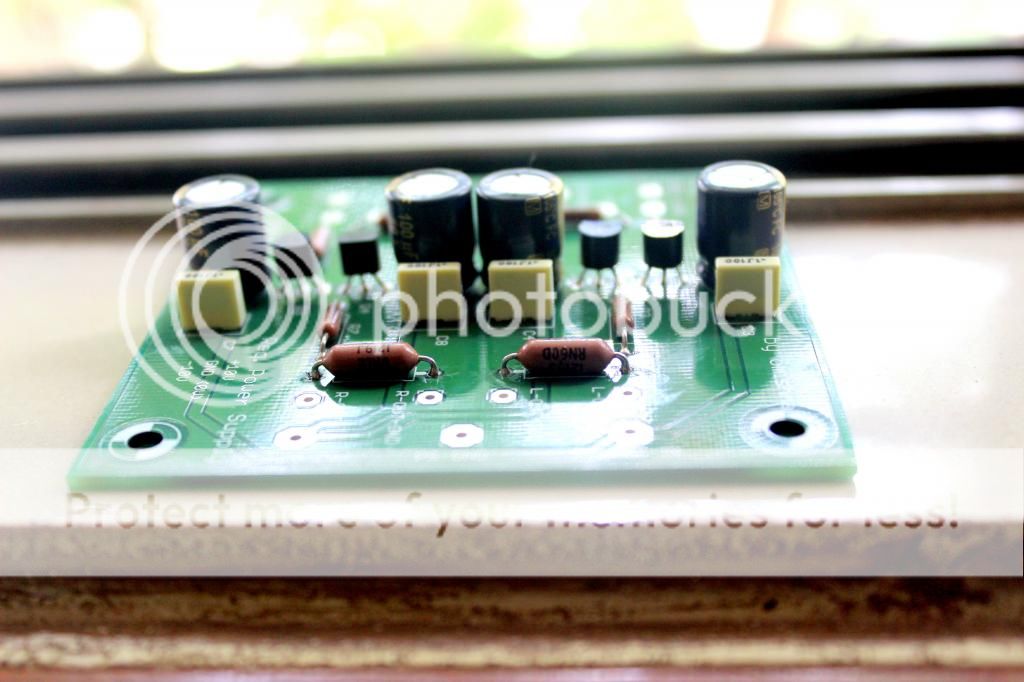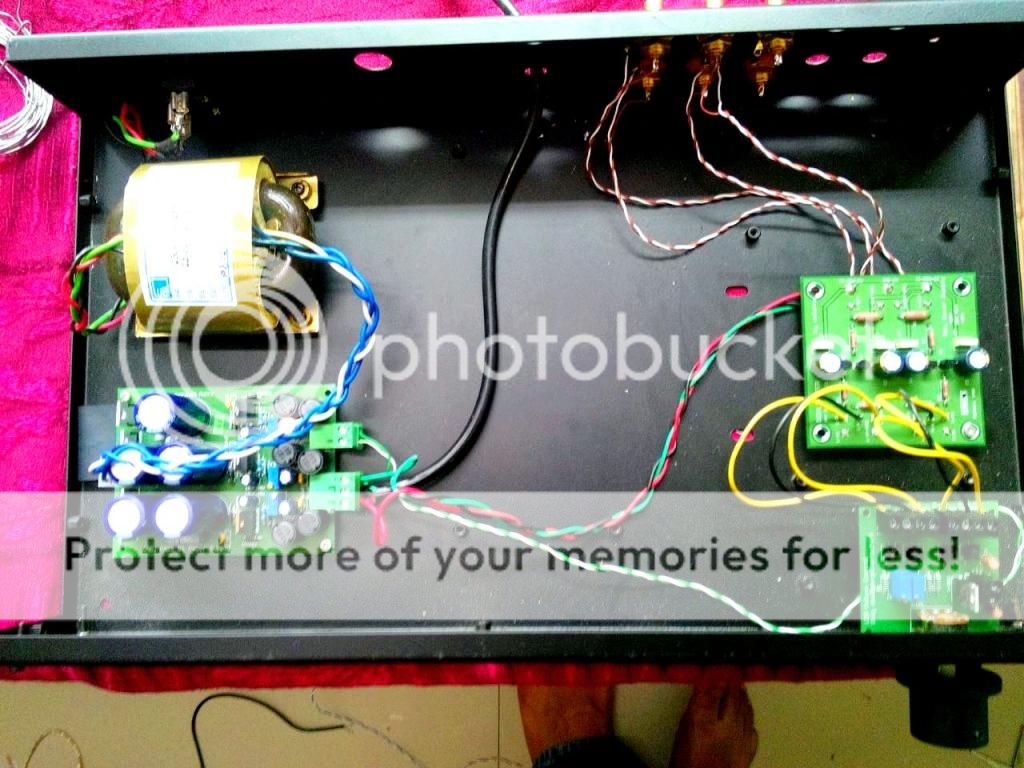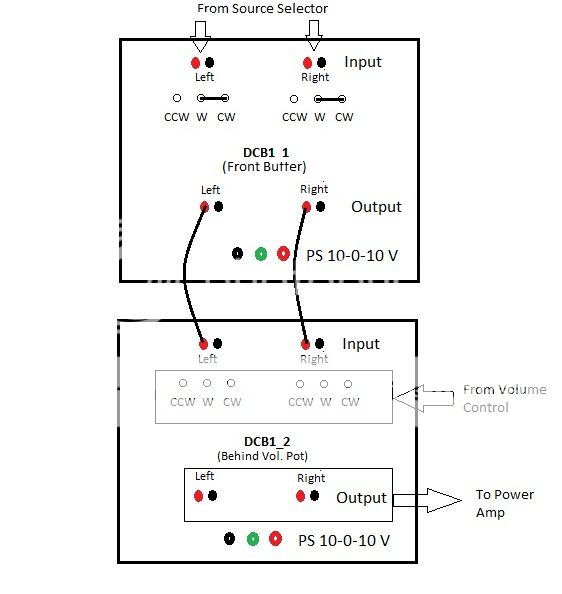For those already enjoying the beautiful sonics of the Pass B1, meet the new avatar of this venerable buffer - the Direct Coupled B1.
For those in a hurry, here's the long story short - it is much better than the B1 in every meaningful way.
Building it - my kit is the version designed by omishra. The board is tiny - 3 inch x 3 inch square, with clear labels. Part count is very low. One can complete the soldering in less than an hour. It takes another hour to wire it up in a cabinet if you already have power supply.
The active part of the circuitry consists of four matched, low-noise JFETs (2SK170). Resistors are high quality Dale. Electrolytic and non-electrolytic caps are also of very high quality. As usual Sachin has gathered some of the best parts from across the globe. Hats off to you, omishra and sachu888. You, sirs, are a constant blessing to the solder jock community.
Assembly was a breeze. It needs -10V/0/+10V DC supply. I have powered it from omishra's versatile and brilliant OPS power supply. The -15V/0/+15V part of the OPS is recalibrated for -10/+10V supply using the built-in Bourns adjustment pots.
Checks and Calibrations - capacitors in the signal path are bad. Period. They mess up the channel separation, and different capacitors smear the signal in their own sweet ways, and what you finally hear is a much degraded version of what comes out from the source. But they are a necessary evil. Mostly.
Ensure that the -ve and +ve supplies are symmetrical. The pots on the OPS allows fine tuning down to 0.01 mV if you have the patience (and a resolving DMM).
The JFETs need to be closely matched for symmetrical DC offsets in the channels.
To check for DC offset, power it up without input signal, check for DC voltage on the left and right outputs. Use 200mV DC voltage range (or lower) on your multimeter. If you have two DMMs you can simultaneously monitor both left and right channel DC offsets. Less than 5 mV is safe but ideally it must be about 0.5 mV. Mine were ~0 and about 0.56mV. The offset values are a function of how closely matched the JFETs are, and how symmetrical the power supply rails are. The diyaudio build thread mentions that one can skew the supply voltages a bit (instead of having them exactly -10/+10V) to achieve near 0.5 mV value caused by unmatched JFETs. I wasn't successful in achieving better figures as adjustement to one power rail voltage affected both offset values simultaneously in a linear sort of relationship. Since mine were near perfect, I just reverted back to the original rail voltages.
High DC offset in the output is dangerous IF your power amp does not have a capacitor in its signal path. So do check whether your power amp has it or not. If it doesn't (like the Pass F5), don't use the DCB1 unless you have a safe DC offset value (as mentioned above), or you can end up blowing your speakers with high DC.
Burn-in - initially it sounded like my B1, and I was thinking to myself, "what's the fuss all about?" After two days' worth of playing and always keeping it always powered on, this little buffer transformed into a very different animal.
Sonics - for a serious listening, I burned a new CD of 14 tracks. The first impression is that everything sounded clearer. All comparisons are to the resistor-modded B1. For the sake of consistency, source is CD player only, using familiar test tracks. I will try to break down "clearer" into its component parts.
Separation of voices, lateral soundstage, depth, and layering - I had read on the diyaudio thread that DCB1 excels in imaging and soundstage, making it more 3D-like. I find this to be so true. For me this is the biggest improvement over the stock B1. There is a distinct separation of voices (by which I mean instruments and human vocals) in the lateral space. It is not an approximate and slightly hazy placement of voices but a very specific placement. One can pinpoint the exact location of a voice in the lateral space. It is at first a bit spooky. I was listening to Karajan conducting Sibelius' Symphonic Poem Finlandia. This orchestral composition has huge massed brass section. Suddenly I heard the brass section offset to the far left of center. Woodwinds were offset to the right. This was the first time I'm hearing this track sounding this way, and it sounded kind of disembodied and it was a bit unsettling at first, as I have always heard all the "voices" bunched up in a happy mass, without any of them occupying a demarcated part of the soundstage. It was only when I heard more tracks that I realised that it has superior left-right separation, unmolested by any capacitor in the signal chain. It also allows one to hear layered voices very distinctly along the depth of the soundstage. This means it is able to reproduce micro details better. Example - Michael Buble's rendition of Me and Mrs Jones has thundering deep double bass in the intro, followed by a short and low tinkling piano which is placed to the far left, well behind the main artist's voice. The string section also occupies the same space as the piano, but the high-hat and snare drum are placed slightly right of center, a bit behind the vocalist who is dead center.
Distinct lateral placement has a welcome side effect - centered voices are projected better and stood out more clearly. It sounded as though my speakers have suddenly become shoutier in the midrange, spotlighting centered vocals and piano/sax/etc. The soundstage now goes a bit deeper than before and one can clearly discern the layers buried deeper into the mix. To those used to a more forward soundstage, the effect of a more laidback soundstage may not be to their liking. It sounds great to me, though. The best sounding setups, to my ears, have deep, deep soundstage. The overall clarity has gone up so one wants to listen at higher volume to soak in more of the music, and one can do it it without fatiguing the ears.
Tonality - this is the second outstanding improvement. I find a beautiful bloom in the midrange. Piano and vocals benefit hugely, as does any other mid-centric voice. Example - the piano accompaniment on Barb Jungr's Lilac Wine suddenly sounded more sonorous, with a nice bloom, bringing out the resonance of the sounding board, and it decayed more elegantly too. And vocals have more presence that reaches out to you.
Openness, Effortlessness - there is a new-found openness, and a sense that everything is playing much more effortlessly. These traits, IMHO, is a hallmark of carefully put together systems. Achieving it for so little outlay is an amazing feat. These are much sought-after features, and are I therefore welcome them with wide open arms and a wet French kiss
Resolution - has taken a quantum jump. In fact I would go out on a limb and say it is very, very resolving and brings out low-level details hidden deep in the mix. This is the third major improvement.
Bass - B1's bass was already good and there was hardly anything more one would want, but the DCB1 gives you more by way of better bass tonality. The weight is also heftier. For a mid-sized BS like mine, that's sweet manna from heaven.
Mids - sounds very beautiful, open and much more palpable. A number of female vocals were harmed in the process, though Male vocals, too
Male vocals, too
Highs - the B1 always did highs very well but I think I hear more fluidity, shimmer and air.
Attack and Decay - the decay is gentle, giving rise to a sense of effortlessness and openness.
Disadvantages - the board is a purist design, meant for only one input. You may need to incorporate a source selector circuitry if you have multiple sources.
What's better than the DCB1? - double decker DCB1, of course And perhaps the hot rodded DCB1 from Salas, with a chunky heatsink and uprated resistors. I think I will also try the double decker like sann did (he's raving about it
And perhaps the hot rodded DCB1 from Salas, with a chunky heatsink and uprated resistors. I think I will also try the double decker like sann did (he's raving about it ).
).
I also plan to build the Salas hot-rodded sometime in the future.
To conclude, my initial doubts whether a non-hot rodded DCB1 would be any better than a regular B1, has been comprehensively proven to be unfounded. This is a worthy and major upgrade over the B1. Strongly recommended.
Some build pics:
Bare board:

Populated board:

Temporary housing inside the B1 cabinet:

For those in a hurry, here's the long story short - it is much better than the B1 in every meaningful way.
Building it - my kit is the version designed by omishra. The board is tiny - 3 inch x 3 inch square, with clear labels. Part count is very low. One can complete the soldering in less than an hour. It takes another hour to wire it up in a cabinet if you already have power supply.
The active part of the circuitry consists of four matched, low-noise JFETs (2SK170). Resistors are high quality Dale. Electrolytic and non-electrolytic caps are also of very high quality. As usual Sachin has gathered some of the best parts from across the globe. Hats off to you, omishra and sachu888. You, sirs, are a constant blessing to the solder jock community.
Assembly was a breeze. It needs -10V/0/+10V DC supply. I have powered it from omishra's versatile and brilliant OPS power supply. The -15V/0/+15V part of the OPS is recalibrated for -10/+10V supply using the built-in Bourns adjustment pots.
Checks and Calibrations - capacitors in the signal path are bad. Period. They mess up the channel separation, and different capacitors smear the signal in their own sweet ways, and what you finally hear is a much degraded version of what comes out from the source. But they are a necessary evil. Mostly.
Ensure that the -ve and +ve supplies are symmetrical. The pots on the OPS allows fine tuning down to 0.01 mV if you have the patience (and a resolving DMM).
The JFETs need to be closely matched for symmetrical DC offsets in the channels.
To check for DC offset, power it up without input signal, check for DC voltage on the left and right outputs. Use 200mV DC voltage range (or lower) on your multimeter. If you have two DMMs you can simultaneously monitor both left and right channel DC offsets. Less than 5 mV is safe but ideally it must be about 0.5 mV. Mine were ~0 and about 0.56mV. The offset values are a function of how closely matched the JFETs are, and how symmetrical the power supply rails are. The diyaudio build thread mentions that one can skew the supply voltages a bit (instead of having them exactly -10/+10V) to achieve near 0.5 mV value caused by unmatched JFETs. I wasn't successful in achieving better figures as adjustement to one power rail voltage affected both offset values simultaneously in a linear sort of relationship. Since mine were near perfect, I just reverted back to the original rail voltages.
High DC offset in the output is dangerous IF your power amp does not have a capacitor in its signal path. So do check whether your power amp has it or not. If it doesn't (like the Pass F5), don't use the DCB1 unless you have a safe DC offset value (as mentioned above), or you can end up blowing your speakers with high DC.
Burn-in - initially it sounded like my B1, and I was thinking to myself, "what's the fuss all about?" After two days' worth of playing and always keeping it always powered on, this little buffer transformed into a very different animal.
Sonics - for a serious listening, I burned a new CD of 14 tracks. The first impression is that everything sounded clearer. All comparisons are to the resistor-modded B1. For the sake of consistency, source is CD player only, using familiar test tracks. I will try to break down "clearer" into its component parts.
Separation of voices, lateral soundstage, depth, and layering - I had read on the diyaudio thread that DCB1 excels in imaging and soundstage, making it more 3D-like. I find this to be so true. For me this is the biggest improvement over the stock B1. There is a distinct separation of voices (by which I mean instruments and human vocals) in the lateral space. It is not an approximate and slightly hazy placement of voices but a very specific placement. One can pinpoint the exact location of a voice in the lateral space. It is at first a bit spooky. I was listening to Karajan conducting Sibelius' Symphonic Poem Finlandia. This orchestral composition has huge massed brass section. Suddenly I heard the brass section offset to the far left of center. Woodwinds were offset to the right. This was the first time I'm hearing this track sounding this way, and it sounded kind of disembodied and it was a bit unsettling at first, as I have always heard all the "voices" bunched up in a happy mass, without any of them occupying a demarcated part of the soundstage. It was only when I heard more tracks that I realised that it has superior left-right separation, unmolested by any capacitor in the signal chain. It also allows one to hear layered voices very distinctly along the depth of the soundstage. This means it is able to reproduce micro details better. Example - Michael Buble's rendition of Me and Mrs Jones has thundering deep double bass in the intro, followed by a short and low tinkling piano which is placed to the far left, well behind the main artist's voice. The string section also occupies the same space as the piano, but the high-hat and snare drum are placed slightly right of center, a bit behind the vocalist who is dead center.
Distinct lateral placement has a welcome side effect - centered voices are projected better and stood out more clearly. It sounded as though my speakers have suddenly become shoutier in the midrange, spotlighting centered vocals and piano/sax/etc. The soundstage now goes a bit deeper than before and one can clearly discern the layers buried deeper into the mix. To those used to a more forward soundstage, the effect of a more laidback soundstage may not be to their liking. It sounds great to me, though. The best sounding setups, to my ears, have deep, deep soundstage. The overall clarity has gone up so one wants to listen at higher volume to soak in more of the music, and one can do it it without fatiguing the ears.
Tonality - this is the second outstanding improvement. I find a beautiful bloom in the midrange. Piano and vocals benefit hugely, as does any other mid-centric voice. Example - the piano accompaniment on Barb Jungr's Lilac Wine suddenly sounded more sonorous, with a nice bloom, bringing out the resonance of the sounding board, and it decayed more elegantly too. And vocals have more presence that reaches out to you.
Openness, Effortlessness - there is a new-found openness, and a sense that everything is playing much more effortlessly. These traits, IMHO, is a hallmark of carefully put together systems. Achieving it for so little outlay is an amazing feat. These are much sought-after features, and are I therefore welcome them with wide open arms and a wet French kiss
Resolution - has taken a quantum jump. In fact I would go out on a limb and say it is very, very resolving and brings out low-level details hidden deep in the mix. This is the third major improvement.
Bass - B1's bass was already good and there was hardly anything more one would want, but the DCB1 gives you more by way of better bass tonality. The weight is also heftier. For a mid-sized BS like mine, that's sweet manna from heaven.
Mids - sounds very beautiful, open and much more palpable. A number of female vocals were harmed in the process, though
Highs - the B1 always did highs very well but I think I hear more fluidity, shimmer and air.
Attack and Decay - the decay is gentle, giving rise to a sense of effortlessness and openness.
Disadvantages - the board is a purist design, meant for only one input. You may need to incorporate a source selector circuitry if you have multiple sources.
What's better than the DCB1? - double decker DCB1, of course
I also plan to build the Salas hot-rodded sometime in the future.
To conclude, my initial doubts whether a non-hot rodded DCB1 would be any better than a regular B1, has been comprehensively proven to be unfounded. This is a worthy and major upgrade over the B1. Strongly recommended.
Some build pics:
Bare board:

Populated board:

Temporary housing inside the B1 cabinet:



